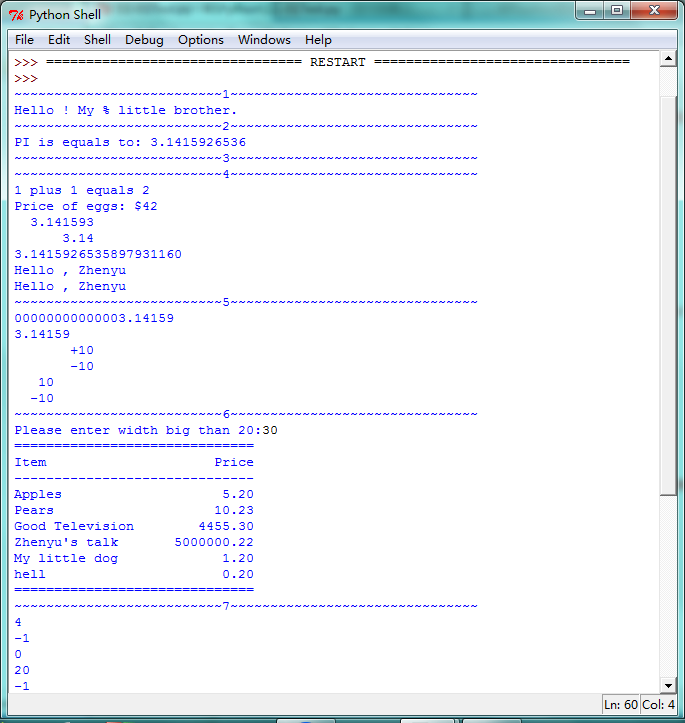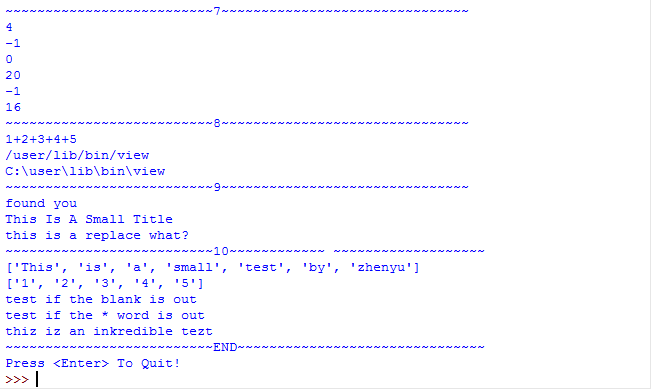列表、字符串和字典是Python中最重要的三种数据类型。
Python中字符串是不可改变的,所以像对元组那样对它进行分片赋值是不合理的。
下面我们介绍一些Python基础字符串操作:
1.字符串格式化
使用求模操作符%可以将其他的值转换为包含转换标志的字符串。还可以用来对值进行不同方式的格式化,比如左右对齐,设置宽度精度,增加符号等操作。
2.字符串方法
字符串有很多中方法,在下面的例子中会一一介绍。
好,下面直接捞干的,直接上例子:
# -*- coding: GBK -*-
#首先用于确定编码,加上这句
print "~~~~~~~~~~~~~~~~~~~~~~~~~~1~~~~~~~~~~~~~~~~~~~~~~~~~~~~~~~"
#请记住:字符串是不可改变的,所以对字符串进行分片赋值是不合法的
#但是可以使用格式化操作符(%)对字符串进行格式化,左侧为想格式化的字符串,右侧为元组
#%s称为转换说明符,标记需要插入转化值的位置
#若要打印%,则需要连续写两个%%
old = "%s ! My %% little %s."
new = ("Hello",'brother')
print old % new
print "~~~~~~~~~~~~~~~~~~~~~~~~~~2~~~~~~~~~~~~~~~~~~~~~~~~~~~~~~~"
#还可以使用格式化操作符进行精度控制(%.数字f),表示保留几位小数
from math import pi
word = "PI is equals to: %.10f"
print word % pi
print "~~~~~~~~~~~~~~~~~~~~~~~~~~3~~~~~~~~~~~~~~~~~~~~~~~~~~~~~~~"
#还可以使用模版字符串对字符串进行格式化,string.substitute(tihuan = 'newString')
#使用tihuan字符串的值newString替换string中的$tihuan
#若要打印$,则需要连续写两个$$
##from string import Template
##s = Template('Two $one or not two $one ,you are a $two')
##d = {}
##d['one'] = 'B'
##d['two'] = '2B'
##s.substitute(d)
##print s
print "~~~~~~~~~~~~~~~~~~~~~~~~~~4~~~~~~~~~~~~~~~~~~~~~~~~~~~~~~~"
#以下是字符串格式化完整版,%后的参数表示不同含义,其中s表示转换成字符串,f表示十进制浮点数等
print '%s plus %s equals %s' % (1,1,2)
print 'Price of eggs: $%d' % 42
#对浮点数进行宽度和精度设置(%宽度.精度f)
print '%10f' % pi
print '%10.2f' % pi
print '%10.19f' % pi
print 'Hello , %.6s' %'ZhenyuJiang'
#可以从元组中读取所取字符串的长度
print 'Hello , %.*s' %(6,'ZhenyuJiang')
print "~~~~~~~~~~~~~~~~~~~~~~~~~~5~~~~~~~~~~~~~~~~~~~~~~~~~~~~~~~"
#可以用空格,0,+,-对字段的长度进行填充,在宽度之前加上这一标表
#0表示将字段所有剩余部分用0填充
print '%020.5f' % pi
#-用来左对齐数值,让空格在右面
print '%-20.5f' % pi
#+表示无论正数还是负数,都标出符号
print ('%+10d' %10) + '\n' + ('%+10d' %-10)
#空格表示在正数之前加上一个空格,用于对齐正负数
print ('% 5d' %10) + '\n' + ('% 5d' %-10)
print "~~~~~~~~~~~~~~~~~~~~~~~~~~6~~~~~~~~~~~~~~~~~~~~~~~~~~~~~~~"
#一个利用标表让格式对齐的例子
width = input('Please enter width big than 20:')
price_width = 10
item_width = width - price_width
header_format = '%-*s%*s'
formats = '%-*s%*.2f'
print '=' * width
print header_format % (item_width,"Item",price_width,'Price')
print '-' * width
print formats % (item_width,'Apples',price_width,5.2)
print formats % (item_width,'Pears',price_width,10.23)
print formats % (item_width,'Good Television',price_width,4455.299)
print formats % (item_width,"Zhenyu's talk",price_width,5000000.22)
print formats % (item_width,'My little dog',price_width,1.2)
print formats % (item_width,'hell',price_width,0.2)
print '=' * width
print "~~~~~~~~~~~~~~~~~~~~~~~~~~7~~~~~~~~~~~~~~~~~~~~~~~~~~~~~~~"
#字符串的一些函数操作之find,在字符串中查找子串,并返回子串位置的最左端索引,没找到返回-1
print 'Dumplings is my favorite food.'.find('ling')
print 'Dumplings is my favorite food.'.find('you')
#还可以添加起始点和结束点参数
subject = '$$$ Get rich now!!! $$$'
print subject.find('$$$')
#只有起始点,表示从索引1开始,如果有起始点有结束点则包含起始点位置,不包含结束点索引(前含后不含)
print subject.find('$$$',1)
print subject.find('!!!',0,18)
print subject.find('!!!',0,19)
print "~~~~~~~~~~~~~~~~~~~~~~~~~~8~~~~~~~~~~~~~~~~~~~~~~~~~~~~~~~"
#join方法用来在队列中添加元素,将字符串列表连接起来
sep = '+'
seq = ['1','2','3','4','5']
print sep.join(seq)
dirs = ['','user','lib','bin','view']
print '/'.join(dirs)
print 'C:' + '\\'.join(dirs)
print "~~~~~~~~~~~~~~~~~~~~~~~~~~9~~~~~~~~~~~~~~~~~~~~~~~~~~~~~~~"
#lower方法返回字符串的小写字母版,title是将字符串转化为标题格式,即单词首字母大写
name = "ZhenYuLi"
names = ['zhenyuli','huipu','xiaoxinxin']
if name.lower() in names : print 'found you'
print 'this is a small title'.title()
#replace方法用于将字符串中的匹配项进行替换并返回替换后的结果
print 'this is a replace test'.replace('test','what?')
print "~~~~~~~~~~~~~~~~~~~~~~~~~~10~~~~~~~~~~~~ ~~~~~~~~~~~~~~~~~~~"
#split用来将字符串分割成序列,与join操作反过来,不添加参数表示用空格(制表,换行)进行分割
print 'This is a small test by zhenyu'.split()
print '1+2+3+4+5'.split('+')
#strip方法返回去除两侧空格的字符串(比如输入的用户名或密码两侧有空格),也可指定去除的参数
print ' test if the blank is out '.strip()
print '****** test if the * word is out !!!!!******'.strip(' *!')
#translate方法只用于处理单个字符的替换,而不是replace的多个字符替换,需要完成一个转换表
#maketrans有两个参数,把c都变成k,s变成z
from string import maketrans
table = maketrans('cs','kz')
print 'this is an incredible test'.translate(table)
print "~~~~~~~~~~~~~~~~~~~~~~~~~~END~~~~~~~~~~~~~~~~~~~~~~~~~~~~~~~"
#为了避免双击的时候直接一闪退出,在最后面加了这么一句
raw_input("Press <Enter> To Quit!")
最后列出前两篇Python总结:Python基础学习教程(一)之字符串的秘密


























 98
98

 被折叠的 条评论
为什么被折叠?
被折叠的 条评论
为什么被折叠?








